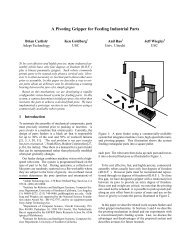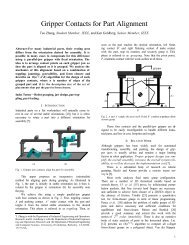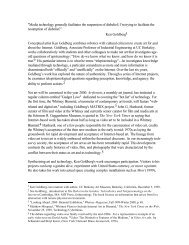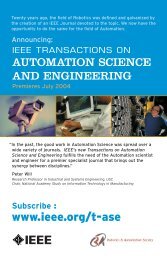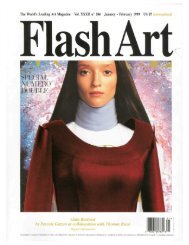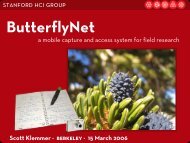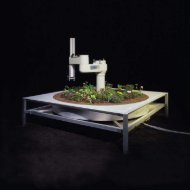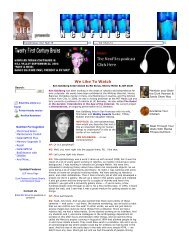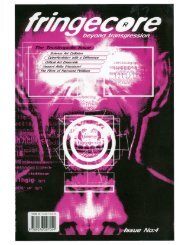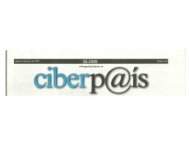0.5MB .pdf - Ken Goldberg - University of California, Berkeley
0.5MB .pdf - Ken Goldberg - University of California, Berkeley
0.5MB .pdf - Ken Goldberg - University of California, Berkeley
Create successful ePaper yourself
Turn your PDF publications into a flip-book with our unique Google optimized e-Paper software.
1362 THE INTERNATIONAL JOURNAL OF ROBOTICS RESEARCH / November/December 2008<br />
Steerable needles are controlled by two degrees <strong>of</strong> freedom actuated<br />
at the needle base: the insertion distance and the bevel<br />
direction. Webster et al. (2006a) experimentally demonstrated<br />
that, under ideal conditions, a flexible bevel-tip needle cuts a<br />
path <strong>of</strong> constant curvature in the direction <strong>of</strong> the bevel, and the<br />
needle shaft bends to follow the path cut by the bevel tip. In a<br />
plane, a needle subject to this non-holonomic constraint based<br />
on bevel direction is equivalent to a Dubins car that can only<br />
steer its wheels far left or far right but cannot go straight.<br />
The steerable needle motion planning problem is to determine<br />
a sequence <strong>of</strong> actions (insertions and direction changes)<br />
so that the needle tip reaches the specified target while avoiding<br />
obstacles and staying inside the workspace. Given a segmented<br />
medical image <strong>of</strong> the target, obstacles and starting location,<br />
the feasible workspace for motion planning is defined<br />
by the s<strong>of</strong>t tissues through which the needle can be steered.<br />
Obstacles represent tissues that cannot be cut by the needle,<br />
such as bone, or sensitive tissues that should not be damaged,<br />
such as nerves or arteries.<br />
We consider motion planning for steerable needles in the<br />
context <strong>of</strong> an image-guided procedure: real-time imaging and<br />
computer vision algorithms are used to track the position and<br />
orientation <strong>of</strong> the needle tip in the tissue. Recently developed<br />
methods can provide this information for a variety <strong>of</strong> imaging<br />
modalities (Cleary et al. 2003 DiMaio et al. 2006a). In this<br />
paper, we consider motion plans in an imaging plane since<br />
the speed/resolution trade-<strong>of</strong>f <strong>of</strong> three-dimensional imaging<br />
modalities is generally poor for three-dimensional real-time<br />
interventional applications. With imaging modalities continuing<br />
to improve, we will explore the natural extension <strong>of</strong> our<br />
planning approach to three dimensional in future work.<br />
Whereas many traditional motion planners assume a robot’s<br />
motions are perfectly deterministic and predictable, a needle’s<br />
motion through s<strong>of</strong>t tissue cannot be predicted with certainty<br />
due to patient differences and the difficulty in predicting needle/tissue<br />
interaction. These sources <strong>of</strong> uncertainty may result<br />
in deflections <strong>of</strong> the needle’s orientation, which is a type <strong>of</strong><br />
slip in the motion <strong>of</strong> a Dubins car. Real-time imaging in the<br />
operating room can measure the needle’s current position and<br />
orientation, but this measurement by itself provides no information<br />
about the effect <strong>of</strong> future deflections during insertion.<br />
Since the motion response <strong>of</strong> the needle is not deterministic,<br />
success <strong>of</strong> the procedure can rarely be guaranteed.<br />
We develop a new motion planning approach for steering<br />
flexible needles through s<strong>of</strong>t tissue that explicitly considers<br />
uncertainty in needle motion. To define optimality for a needle<br />
steering plan, we introduce a new objective for image-guided<br />
motion planning: maximizing the probability <strong>of</strong> success.Inthe<br />
case <strong>of</strong> needle steering, the needle insertion procedure continues<br />
until the needle reaches the target (success) or until failure<br />
occurs, where failure is defined as hitting an obstacle, exiting<br />
the feasible workspace or reaching a state in which it is impossible<br />
to prevent the former two outcomes. Our method formulates<br />
the planning problem as a Markov decision process<br />
(MDP) based on an efficient discretization <strong>of</strong> the state space,<br />
models motion uncertainty using probability distributions and<br />
computes optimal actions (within error due to discretization)<br />
for a set <strong>of</strong> feasible states using infinite horizon dynamic programming<br />
(DP).<br />
Our motion planner is designed to run inside a feedback<br />
loop. After the feasible workspace, start region and target are<br />
defined from a pre-procedure image, the motion planner is executed<br />
to compute the optimal action for each state. After the<br />
image-guided procedure begins, an image is acquired, the needle’s<br />
current state (tip position and orientation) is extracted<br />
from the image, the motion planner (quickly) returns the optimal<br />
action to perform for that state, the action is executed<br />
and the needle may deflect due to motion uncertainty, then the<br />
cycle repeats.<br />
In Figure 1, we apply our motion planner in simulation to<br />
prostate brachytherapy, a medical procedure to treat prostate<br />
cancer in which physicians implant radioactive seeds at precise<br />
locations inside the prostate under ultrasound image guidance.<br />
In this ultrasound image <strong>of</strong> the prostate (segmented by a dotted<br />
line), obstacles correspond to bones, the rectum, the bladder,<br />
the urethra and previously implanted seeds. Brachytherapy is<br />
currently performed in medical practice using rigid needles<br />
here we consider steerable needles capable <strong>of</strong> obstacle avoidance.<br />
We compare the output <strong>of</strong> our new method, which explicitly<br />
considers motion uncertainty, to the output <strong>of</strong> a shortestpath<br />
planner that assumes the needles follow ideal deterministic<br />
motion. Our new method improves the expected probability<br />
<strong>of</strong> success by over 30% compared with shortest path<br />
planning, illustrating the importance <strong>of</strong> explicitly considering<br />
uncertainty in needle motion.<br />
1.1. Related Work<br />
Downloaded from<br />
http://ijr.sagepub.com at UNIV CALIFORNIA BERKELEY LIB on November 25, 2008<br />
Non-holonomic motion planning has a long history in robotics<br />
and related fields (Latombe 1991, 1999 Choset et al.<br />
2005 LaValle 2006). Past work has addressed deterministic<br />
curvature-constrained path planning where a mobile robot’s<br />
path is, like a car, constrained by a minimum turning radius.<br />
Dubins showed that the optimal curvature-constrained trajectory<br />
in open space from a start pose to a target pose can be described<br />
using a discrete set <strong>of</strong> canonical trajectories composed<br />
<strong>of</strong> straight line segments and arcs <strong>of</strong> the minimum radius <strong>of</strong><br />
curvature (Dubins 1957). Jacobs and Canny (1989) considered<br />
polygonal obstacles and constructed a configuration space for<br />
a set <strong>of</strong> canonical trajectories, and Agarwal et al. (2002) developed<br />
a fast algorithm to compute a shortest path inside a convex<br />
polygon. For Reeds–Shepp cars with reverse, Laumond<br />
et al. (1994) developed a non-holonomic planner using recursive<br />
subdivision <strong>of</strong> collision-free paths generated by a lowerlevel<br />
geometric planner, and Bicchi et al. (1996) proposed a<br />
technique that provides the shortest path for circular unicycles.<br />
Sellen (1998) developed a discrete state-space approach



